One of the greatest English artists and most renowned artists of the Romantic era was also extremely prolific. J.M.W. Turner (1775-1851) became a member of the Royal Academy at the age of 14 and was personally accepted by Sir Joshua Reynolds (1723-1792) a year later.
Turner is best known for his magnificent landscapes and often turbulent marine paintings featuring remarkable color schemes. He left behind a legacy of 550 oil paintings, 2,000 watercolors, and 30,000 drawings on paper.
Although he lived in poor condition during the final period of his life, he died an extremely wealthy man. He exchanged a shabby house in Cheyne Walk in Chelsea for a final resting place in St. Paul’s Cathedral after he died at the age of 76.
In this article, we’ll take a closer look at some of the most famous paintings by Joseph Mallord William Turner, an eccentric artist who dominated landscape painting in the early half of the 19th century.
1. Fishermen at Sea
- Date created: 1796
- Dimensions: 91.44 × 122.24 centimeters (36 x 48.125 inches)
- Location: Tate Britain, London, United Kingdom
Fishermen at Sea is an important painting in the oeuvre of William Turner because it was his first oil painting to be exhibited at the Royal Academy. This happened in 1796, about 6 years after he was accepted at the prestigious art institution.
The painting depicts a wild sea with a small boat full of sailors struggling to control it. The moonlit scene takes place near a chalk rock formation called “The Needles” off the western tip of the Isle of Wight. It was instantly praised and virtually launched the career of Turner.
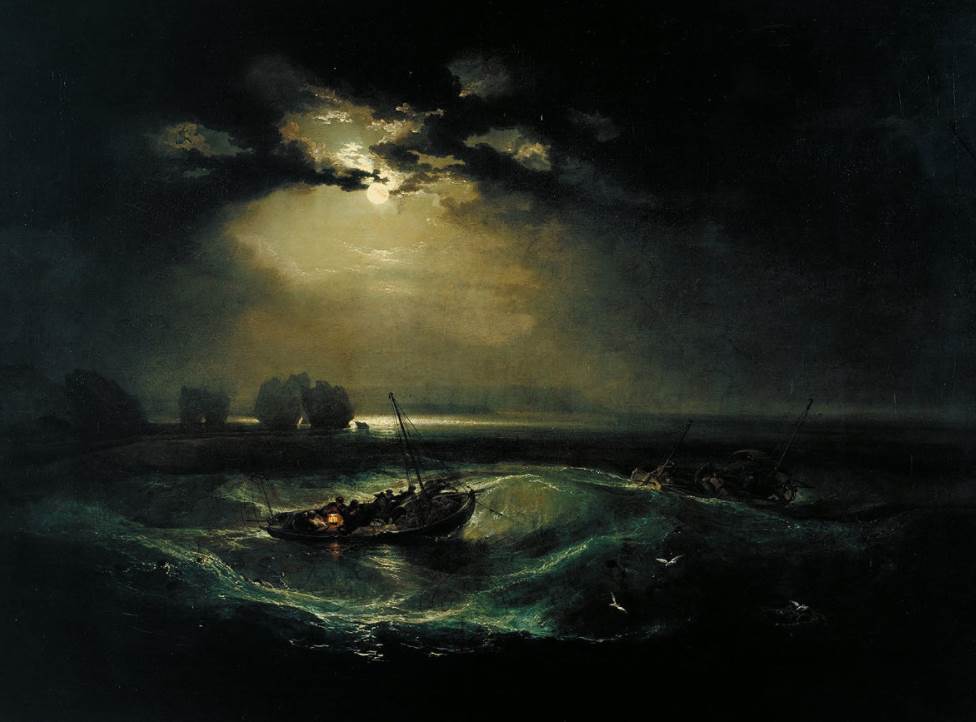
2. The Fighting Temeraire
- Date created: 1839
- Dimensions: 90.7 × 121.6 centimeters (35.7 × 47.9 inches)
- Location: National Gallery, London, United Kingdom
The Fighting Temeraire is another painting by William Turner that was exhibited at the Royal Academy, albeit over 4 decades later in 1839. We can see the difference in the style of the young artist and the mature one.
It depicts the 98-gun HMS Temeraire, one of the ships that fought at the Battle of Trafalgar on October 21, 1805. It’s being towed up by a tugboat up the Thames to its final resting place at Rotherhithe in southeast London to be broken up.
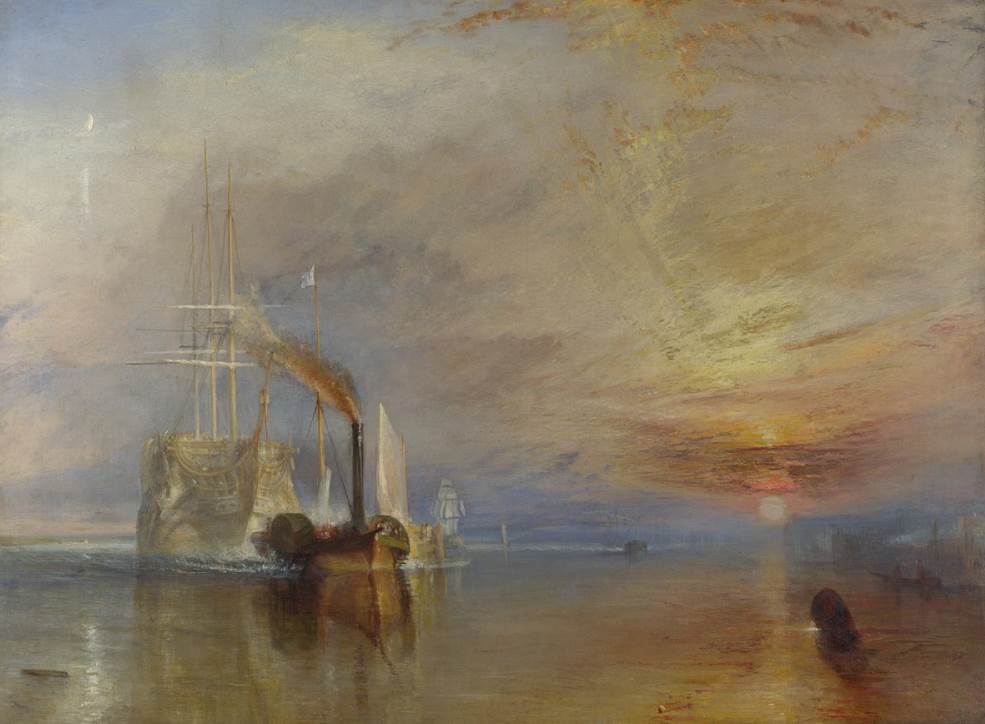
3. Rain, Steam and Speed – The Great Western Railway
- Date created: 1844
- Dimensions: 91 × 121.8 centimeters (36 × 48.0 inches)
- Location: National Gallery, London, United Kingdom
Rain, Steam, and Speed – The Great Western Railway was exhibited at the Royal Academy in the year 1844 although it’s likely that the painting was produced much earlier. It’s a work that emphasizes the unique ability of Turner to paint the perception of speed.
The painting depicts an oncoming train as it approaches the viewer during a rainstorm on a hot summer day. The hazy atmosphere makes it appear that the train is coming out of nowhere. The Great Western Railway connected London with the west and southwest of England.
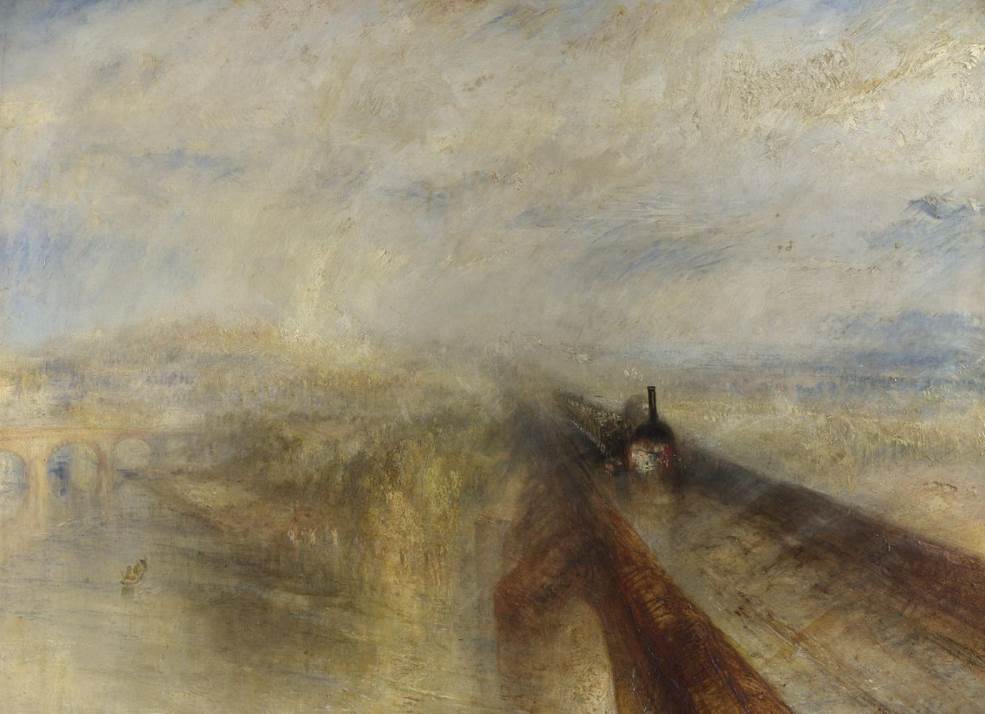
4. Snow Storm: Hannibal and his Army Crossing the Alps
- Date created: 1812
- Dimensions: 146 × 237.5 centimeters (57.5 × 93.5 inches)
- Location: Tate Britain, London, United Kingdom
Snow Storm: Hannibal and his Army Crossing the Alps, is one of the paintings that Turned bequeathed to the British nation. He intended to have a gallery built featuring all his finished works but this never happened and the small fortune he left behind was divided.
The painting depicts an important moment in the history of ancient Rome as the feared warrior Hannibal crossed the Alps in 218 B.C. This event happened during the so-called Second Punic Wars, fought between Carthage and Rome. This crossing was an incredible achievement in ancient times.

5. Dido building Carthage
- Date created: 1815
- Dimensions: 155.5 x 230 centimeters (61.2 x 91 inches)
- Location: National Gallery, London, United Kingdom
Dido Building Carthage is a work that J.M.W. Turner himself described as his Magnum Opus or ultimate masterpiece. It reflects his love for architecture, especially classical structures, and is remarkable because he kept the painting until he died.
The painting depicts the legendary founder and first queen of the city-state of Carthage named Dido. She is directing her architects to build monumental structures in her newly found city. On the right side of the painting, Turner depicted the tomb of her husband Sychaeus, an omen for the fall of Carthage in the future.
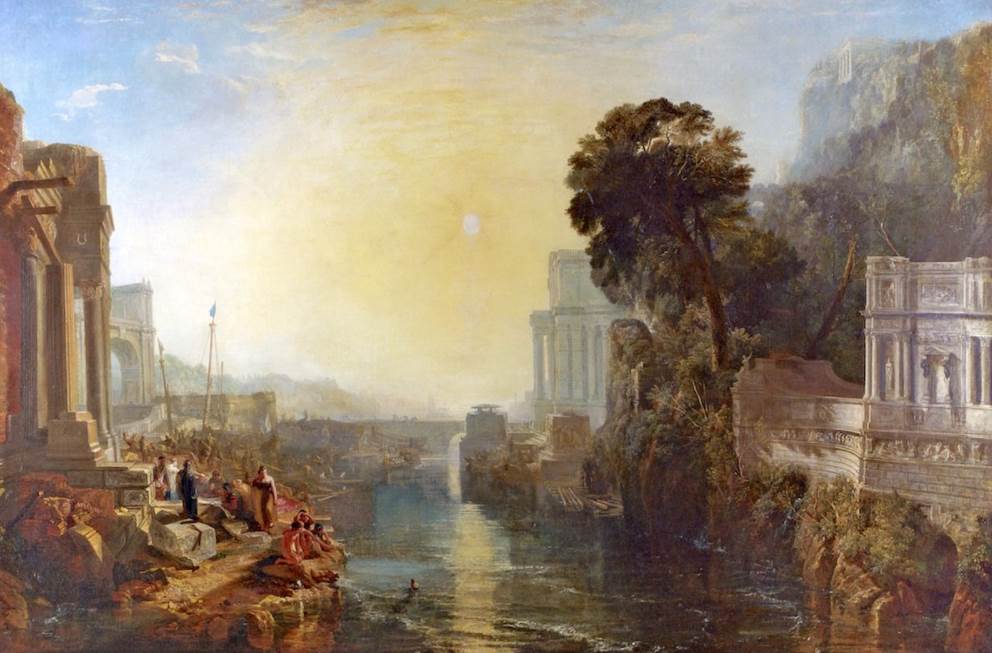
6. The Burning of the Houses of Lords and Commons
- Date created: 1834-1835
- Dimensions: 92.1 by 123.2 centimeters (36.3 x 48.5 inches)
- Location: Philadelphia Museum of Art / Cleveland Museum of Art – United States
The Burning of the Houses of Lords and Commons is also sometimes referred to as The Burning of the Houses of Parliament and depicts the devastating event that took place on October 16, 1834. This was the day that the medieval Palace of Westminster burned to the ground.
William Turner lived in London his entire life and witnessed this event firsthand so the depiction can be described as quite accurate. The flattening of the old building resulted in the new Palace of Westminster, one of the most amazing landmarks in London today.
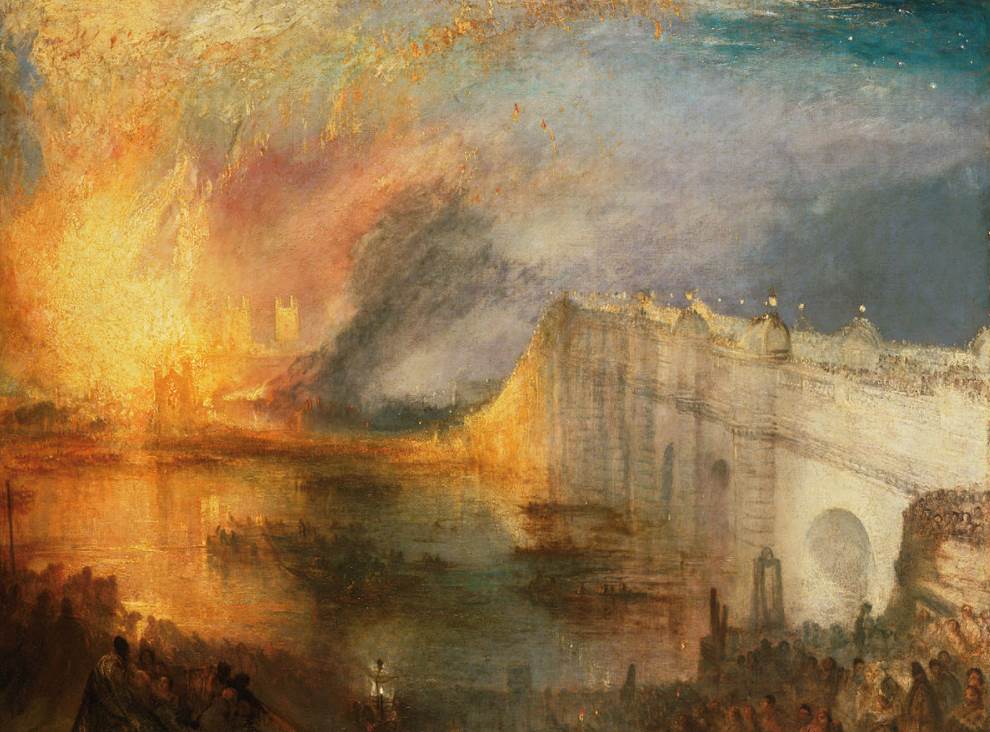
7. The Slave Ship
- Date created: 1840
- Dimensions: 91 × 123 centimeters (36 × 48 inches)
- Location: Museum of Fine Arts, Boston, United States
The Slave Ship was originally known as “Slavers Throwing overboard the Dead and Dying—Typhon coming on,” when it was first displayed at the Royal Academy in 1840. It’s a typical Romantic depiction of a maritime painting.
It’s believed that Turner was inspired by the so-called Zong Massacre, a horrific event in which 142 African slaves died in 1781, probably after being thrown overboard. Turner possibly read a book called “The History and Abolition of the Slave Trade” before producing this work.

8. Norham Castle, Sunrise
- Date created: 1845
- Dimensions: 90.8 × 121.9 centimeters (35.7 × 48.0 inches)
- Location: Tate Britain, London, United Kingdom
Norham Castle, Sunrise depicts the castle of Norham, a small village in Northumberland, a county in North East England. This historic castle overlooks the River Tweed and was an important fortification in the proximity of the border with Scotland.
Turner already painted a watercolor version of the castle after he visited the area in 1797. This was a work exhibited at the Royal Academy and received a lot of praise. He produced this work on the same subject during the final decade of his life.
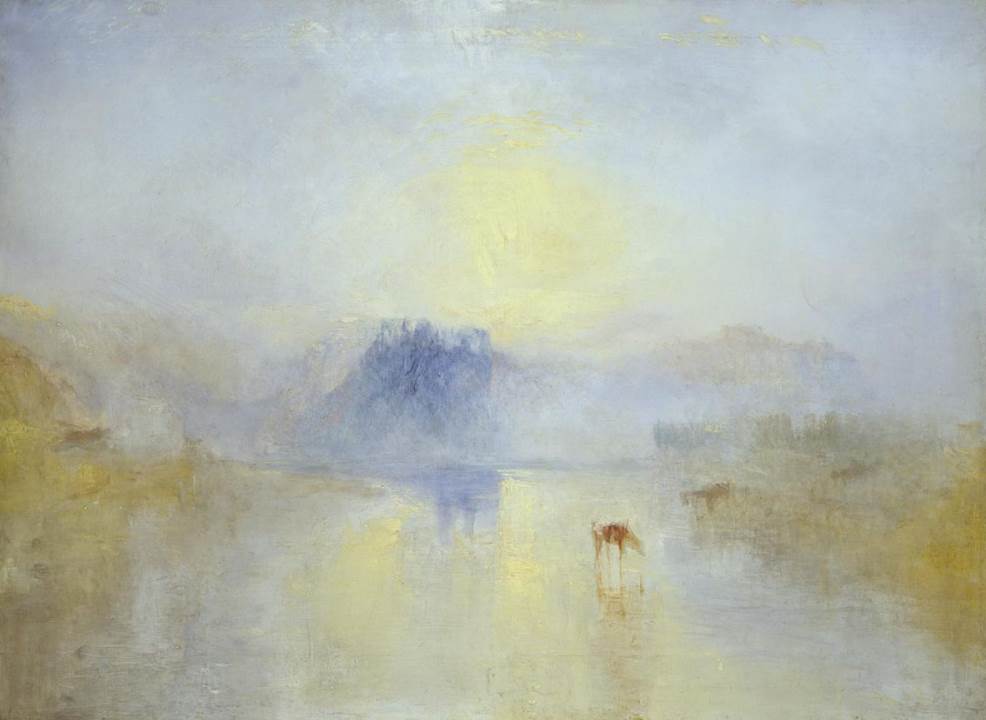
9. Snow Storm: Steam-Boat off a Harbour’s Mouth
- Date created: 1842
- Dimensions: 91 × 122 centimeters (36 × 48 inches)
- Location: Tate Britain, London, United Kingdom
Snow Storm: Steam-Boat off a Harbour’s Mouth is officially known as “Snow Storm – Steam-Boat off a Harbour’s Mouth Making Signals in Shallow Water, and going by the Lead. The Author was in this Storm on the Night the “Ariel” left Harwich” and is one of the most remarkable J.M.W. paintings for several reasons.
Although some critics didn’t appreciate it initially, some saw it for the masterpiece it is as it depicts the raw sense of motion one can experience at sea. And that’s exactly what Turner aimed to achieve after he was able to experience this type of weather in a wild sea himself at the age of 67.
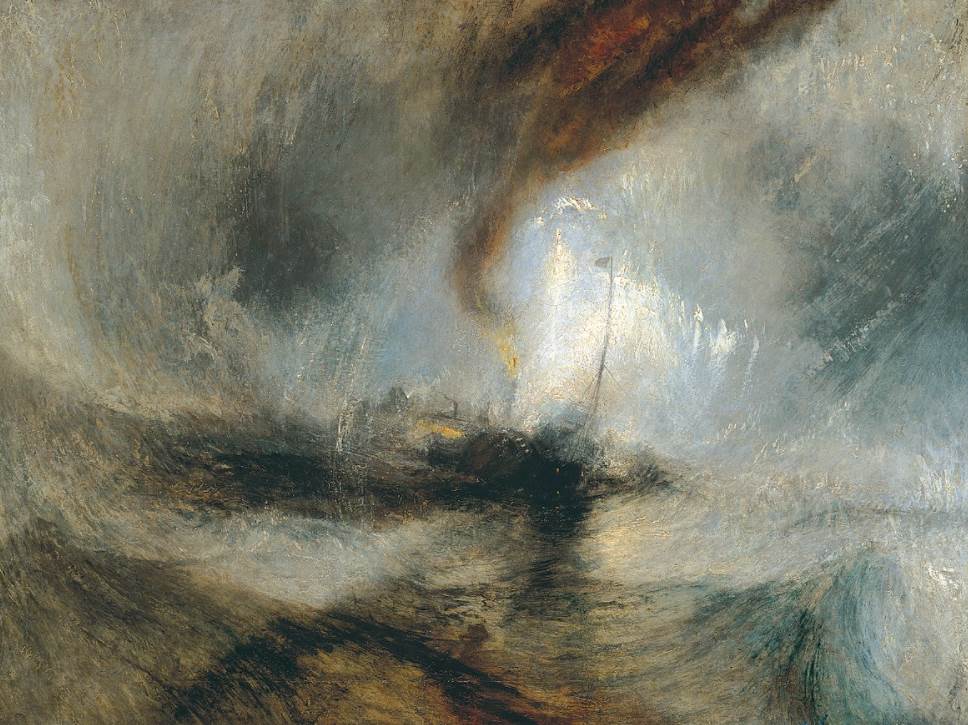
10. Modern Rome – Campo Vaccino
- Date created: 1839
- Dimensions: 90.2 × 122 centimeters (35.5 × 48 inches)
- Location: J. Paul Getty Museum, Los Angeles, United States
Modern Rome – Campo Vaccino was the final painting of Rome that J.M.W. Turner produced in his life. It depicts the Roman Forum before it was completely excavated and was still referred to as the “Campo Vaccino” or “Cow Square.” Yes, The ancient Roman marketplace wasn’t a popular tourist attraction back then but was populated by grazing cows.
This remarkable work of art had been privately owned by the family of the 5th Earl of Rosebery since 1878. It was put up for auction in 2010 and although it was expected to sell for at least £18 million, it was sold just 5 minutes after the auction went live for £29.7 million, the record for a painting by Turner at the time. This was shattered once more when his work “Rome, from Mount Aventine,” sold for £30.3 million in 2014.



